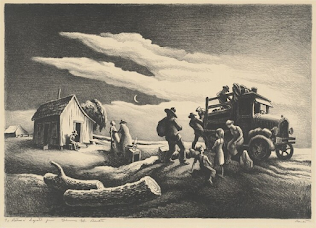A Philosopher Lecturing on the Orrery, 1776
The artwork above was created by Joseph Wright of Derby on 1763 it is unknown where he created the painting but he did live in Derby England where he stayed for most of his career. The name "Of Derby" stands for the place he lives so that he would be distinguished by the rest of the artist that lived there.
This artwork captures a philosopher gathered around an orrery a model of the solar system teaching a lecture. The artist used oil paint it makes the artwork look alive. Jospeh Wright of Derby is known for his contrast between light and dark an example of this is the man in the red coat almost looks like he has a light shinning on his face which is very original. relates to Art and scientific discovery. I would own a copy of this artwork. A website called Khan Academy states that "The age of Enlightenment is most closely associated with scientists and inventors, but writers and artists also played major roles. They helped spread enlightenment concepts via the written word and printed image, and inspired others to think rationally about the world in which they lived." The artwork was created during the age of enlightenment and helped others look at science in a different light. The idea behind this artwork was that advance science could advance society.
“Wright of Derby, a Philosopher Lecturing on the Orrery (Article).” Khan Academy, Khan Academy, https://www.khanacademy.org/humanities/ap-art-history/later-europe-and-americas/enlightenment-revolution/a/wright-of-derby-a-philosopher-lecturing-on-the-orrery.
Madame François Buron, 1769
This artwork was created by Jacques Louis David in France on 1769. Jacques Louis David was a french painter in the neoclassical age. Jacques was raised by his uncle following his fathers death his uncle wanted him to become an architect but Jacques wanted to become a painter his aunt Madame Francois Buron supported him in wanting to become a painter therefore was his inspiration to paint a portrait of her.
The painter used oil painting to convey this artwork. Something that stands out to me is the way he painted her dress the detailed edges and the dress flaps makes the dress come to live with the texture he adds to it. The artist wanted to portray her as having a "warm reserve" I think she does look caught off guard in a way while reading her book. The book stands out to me because in a way it looks worn out since its crumpled up in the corners.
This artwork relates to the art and scientific discovery in an art appreciation blog titled Nichbathe they state "This photo is a great example of how women where also included in the enlightenment. The way he paints Madame Francois Buron in such a studious way makes you really realize how impact full this period was in changing paintings." This artwork relates to science because it relates to the enlightenment period it shows how women wanted to be educated as well. I would own a copy of this artwork.
Nichbathe. “Classical Art and Scientific Discovery in the 1700's.” Nichbathe, 17 Oct. 2014, https://nichbathe.wordpress.com/2014/10/17/classical-art-and-scientific-discovery-in-the-1700s/.
David, Jacques Louis. “Madame François Buron.” The Art Institute of Chicago, Painting and Sculpture of Europe, 1 Jan. 1769, https://www.artic.edu/artworks/88632/madame-francois-buron.
Captain Thomas Coram, 1740
The artwork is a portrait of Captain Thomas Coram created by William Hograth on 1740's in London. This was the first contemporary British art that was created. Captain Thomas Coram had an idea of creating a Fondling hospital and was supported by William Hograth. The hospital is now known as "The children's charity Coram" is a place to educate and care for poor children. William Hograth grew up as a very poor child at the time if your family member went to jail your whole family would go which created the idea to support Coram's idea.
I would own my own copy of this artwork. The first thing that stands out to me is the facial expression looks like he is smiling. This artwork is related to art and scientific discovery. In the art blog titled Kastriker they say "This captain had many oversea adventures. This is represented in the painting with the globe. There is also a book open at his feet and scripts rolled next to him." Captain Thomas Coram discovered during the enlightenment period by boat and through writings.
“Captain Thomas Coram (1668–1751).” Captain Thomas Coram (1668–1751) | Art UK, https://artuk.org/discover/artworks/captain-thomas-coram-16681751-191925.
Kastriker. “Art and Scientific Discovery in the 1700's.” Kastriker, 15 Oct. 2015, https://kastriker.wordpress.com/2015/10/15/art-and-scientific-discovery-in-the-1700s/.





I enjoyed looking through the three pieces of art you provided! It was interesting to read through your commentary on how the pieces related to the influence of art and scientific discovery. I also really enjoy the texture David was adding to the dress in his work Madame Francois Buron. It is small details like these that really make the portraits come to life. I personally am not fond of the more somber colors of the Classical Era, but I still found myself coming to appreciate their rich history and significance.
ReplyDeleteThe influence of scientific discovery was prevalent and apparent in all of the pieces you chose. From the orrery to the book and finishing with the globe. All three of these objects really encapsulate the influence of science in the 1700s. I think it is awesome that you would want to own any one of these pieces. I personally found that I was not really attached to any pieces in this era, but I loved learning about them in more depth. The Death of Socrates also by David was one piece I found intriguing to learn about and maybe you would as well. This was a great discussion!
Hello Michelle, nice work on your blog this week. You picked 3 great works for this assignment. The one I enjoyed the most was the first one; A Philosopher Lecturing on the Orrery, 1776. The dark background and the center of attention illuminating the people is very appealing to me. Its a great example of tenebrism being used in a work of art. I also found a work of art by joseph wright and I think many of his works showcase a use of tenebrism. Each of the works you have presented did indeed showcase some scientific discovery or aspect. The title and contents of each work make this apparent. Great job finding these painting to fit this theme and keep up the great work.
ReplyDelete